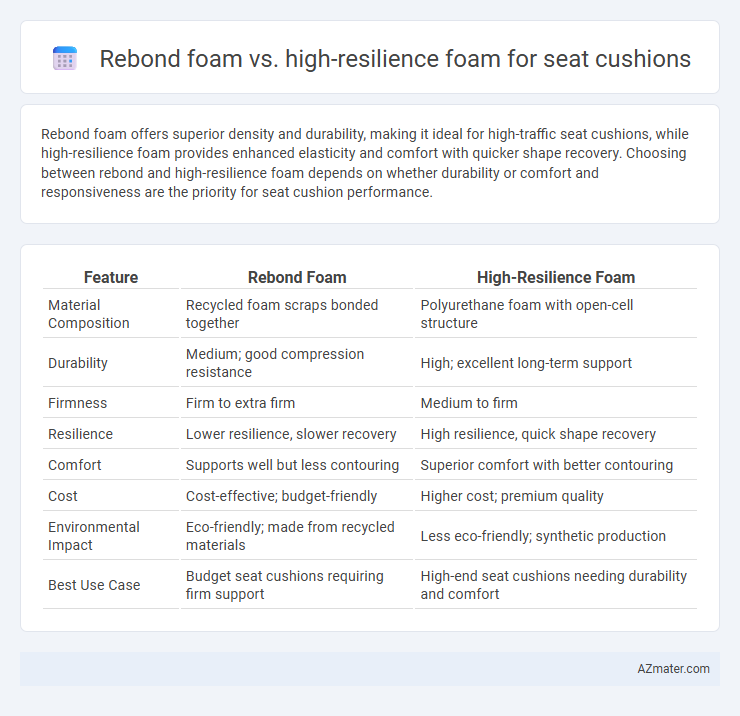Rebond foam offers superior density and durability, making it ideal for high-traffic seat cushions, while high-resilience foam provides enhanced elasticity and comfort with quicker shape recovery. Choosing between rebond and high-resilience foam depends on whether durability or comfort and responsiveness are the priority for seat cushion performance.
Table of Comparison
| Feature | Rebond Foam | High-Resilience Foam |
|---|---|---|
| Material Composition | Recycled foam scraps bonded together | Polyurethane foam with open-cell structure |
| Durability | Medium; good compression resistance | High; excellent long-term support |
| Firmness | Firm to extra firm | Medium to firm |
| Resilience | Lower resilience, slower recovery | High resilience, quick shape recovery |
| Comfort | Supports well but less contouring | Superior comfort with better contouring |
| Cost | Cost-effective; budget-friendly | Higher cost; premium quality |
| Environmental Impact | Eco-friendly; made from recycled materials | Less eco-friendly; synthetic production |
| Best Use Case | Budget seat cushions requiring firm support | High-end seat cushions needing durability and comfort |
Introduction to Rebond Foam and High-Resilience Foam
Rebond foam is made by compressing scrap foam pieces bonded with adhesive, offering dense, durable support ideal for heavy-use seat cushions, while high-resilience foam features a flexible, open-cell structure that provides excellent elasticity and long-lasting comfort. Rebond foam is known for its firmness and durability, often used in commercial seating, whereas high-resilience foam excels in rebound capacity, ensuring cushions retain their shape and provide consistent comfort over time. Both foams cater to different seating requirements, with rebond foam emphasizing structural strength and high-resilience foam prioritizing elasticity and cushioning performance.
Composition and Manufacturing Process
Rebond foam is produced by recycling shredded foam scraps bonded together with adhesives and heat, resulting in a dense, firm foam ideal for heavy-duty cushioning. High-resilience foam is made from polyurethane with a complex open-cell structure that allows for superior elasticity and durability through a controlled chemical foaming process. The manufacturing of high-resilience foam involves higher-quality raw materials and precise curing techniques to optimize support and long-lasting comfort in seat cushions.
Comfort and Support Comparison
Rebond foam provides firm support and moderate comfort by compressing shredded scrap foam bonded together, making it denser and more durable but less responsive to body contours. High-resilience foam offers superior comfort through high elasticity and quick recovery, contouring to the body while maintaining consistent support and reducing pressure points. For seat cushions, high-resilience foam is ideal for prolonged sitting due to enhanced cushioning and resilience, whereas rebond foam suits applications requiring robust, long-lasting support with less emphasis on softness.
Durability and Longevity
Rebond foam, created from shredded polyurethane foam bonded together, offers exceptional durability and resistance to wear, making it ideal for heavy-use seat cushions. High-resilience foam features a higher density and superior elasticity, providing enhanced comfort while maintaining structural integrity over prolonged periods. Both foams excel in longevity, but rebond foam typically outperforms in maintaining shape under continuous pressure, whereas high-resilience foam excels in providing consistent comfort without rapid breakdown.
Breathability and Temperature Regulation
Rebond foam offers moderate breathability due to its dense structure, which can restrict airflow and lead to heat retention in seat cushions. High-resilience foam features an open-cell design that enhances airflow, providing superior temperature regulation and keeping the seating surface cooler during prolonged use. The enhanced breathability of high-resilience foam makes it a preferable choice for maintaining comfort in warm environments.
Cost and Value for Money
Rebond foam is generally more affordable than high-resilience foam, making it a popular choice for budget-conscious seat cushions while providing adequate durability. High-resilience foam offers superior support, longevity, and comfort, often justifying its higher price through enhanced value for money in long-term use. Consumers seeking the best balance of cost and durability should consider seat cushions with high-resilience foam for extended comfort investment.
Environmental Impact and Sustainability
Rebond foam, made from recycled foam scraps, significantly reduces landfill waste and lowers resource consumption, enhancing its sustainability as a seat cushion material. High-resilience (HR) foam, while offering superior durability and comfort, is typically produced from virgin petrochemical-based materials, which have a higher carbon footprint and environmental impact. Choosing rebond foam supports circular economy principles by repurposing waste, whereas HR foam's long lifespan can mitigate frequent replacements but involves more intensive initial resource use.
Suitability for Various Seating Applications
Rebond foam offers superior durability and density, making it ideal for heavy-duty seating applications such as commercial chairs and gym equipment where prolonged support is essential. High-resilience foam provides exceptional bounce and comfort, suitable for residential furniture and office seating that requires cushioning with responsive support. The choice between rebond and high-resilience foam depends largely on the specific seating use, balancing longevity and comfort needs.
Maintenance and Care Requirements
Rebond foam seat cushions require minimal maintenance due to their dense composition, which resists deformation and moisture absorption, making them easy to clean with regular vacuuming and spot cleaning. High-resilience foam cushions demand more attentive care to preserve their elasticity, often needing gentle cleaning methods to avoid breakdown of the open-cell structure and periodic rotation to maintain shape and comfort. Proper maintenance extends the lifespan of both materials, but high-resilience foam benefits more from routine care to prevent sagging and maintain support.
Verdict: Which Foam is Better for Seat Cushions?
Rebond foam, known for its durability and affordability, offers firm support by recycling shredded foam materials, making it a budget-friendly option for seat cushions with moderate comfort. High-resilience foam provides superior comfort and longevity due to its open-cell structure and higher density, which enhances durability and sustained support for prolonged seating. For seat cushions, high-resilience foam is generally better, delivering enhanced comfort, resilience, and durability ideal for frequent use.

Infographic: Rebond foam vs High-resilience foam for Seat cushion
 azmater.com
azmater.com